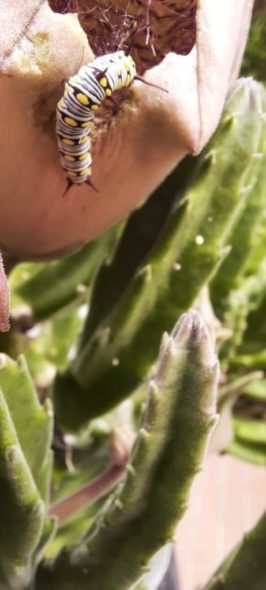Kau Poh Moi observed some Plain Tiger Butterfly (Danaus chrysippus) caterpillars on a Stapelia plant. The caterpillars were already at late instar stages when photographed. They fed on the flower buds day and night. After the adult butterflies emerged, they left their translucent and papery cocoons attached to the succulent stems of the plant.
Plant host: Stapelia
Family : Apocyanaceae
Subfamily: Asclepiadoideae
Interesting snippets: Succulent plants that originate from South Africa. Some species have giant flowers that are 40 cm in diameter. Also known as carrion flowers as they emit a slight foul odour when in bloom. This is a reproductive strategy similar to the Rafflesia spp. Flowers are hairy and star-shaped. Popular as container plants and well-drained soils. Low-growing and generally lacking the long, sharp, spikes of succulents.
Butterfly : Danaus chrysippus
Family : Nymphalidae
Subfamily: Danainae
Interesting snippers: Plain Tiger Butterflies are medium-sized with a wingspan of about 7 cm. Common in Africa, India, Asia, Southern Europe and parts of Australia. Larvae feed mostly on milkweeds ( formerly Asclepiadoideae, now Apocyanaceae) but will feed on Moraceae (figs) and Convolvulaceae (Ipomoea) as well. Adults feed on nectar from various flowers.
Young larvae are predated on by spiders, assassin bugs, cockroaches, ants and mantises. Adults are considered unpalatable as seen by their bright colours which serve as a warning to their predators of their distasteful nature. Larvae which feed on milkweeds accumulate alkaloids which remain in the body of the adults and make them unpalatable to the predators.






Read https://besgroup.org/2018/04/06/the-story-of-the-plain-tiger-butterfly/ by Roy Lim,
https://besgroup.org/2015/11/25/the-plain-tiger-butterfly-and-bougainvillea-flowers/ by YC Wee,
https://besgroup.org/2015/10/22/death-of-a-plain-tiger/ by Khew Sin Khoon,
https://besgroup.org/2011/03/25/white-breasted-woodswallow-takes-a-butterfly/ by Amar Singh HSS and Khew Sin Khoon and
https://besgroup.org/2017/04/03/without-plants-there-would-be-no-birds-3/ by YC Wee.
All photographs courtesy of Kau Poh Moi taken at an apartment compound in Singapore.
Article by Teo Lee Wei.
References:








